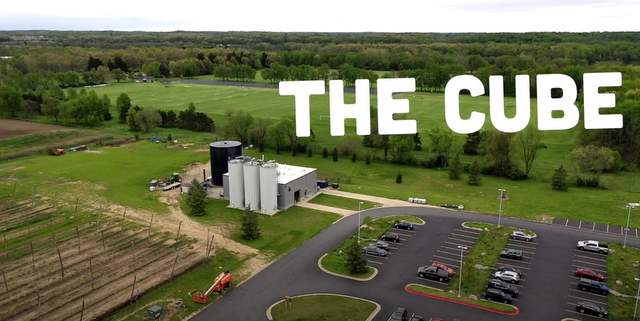Watch how the bacteria in Bell’s Cube wastewater facility are raised on craft beer
Watch how the bacteria in Bell's Cube wastewater facility are raised ... Craft Brewing Business


Bell’s Brewery: A Sustainable Approach to Brewing

Introduction
Bell’s Brewery, based in Comstock, Michigan, is committed to implementing eco-focused business practices that align with the Sustainable Development Goals (SDGs). This report highlights some of the sustainable initiatives undertaken by Bell’s Brewery, with a particular emphasis on their wastewater facility called The Cube.
Geothermal Field and Hop Yard
Bell’s Brewery has installed an 85-ton geothermal field beneath its two-acre hop yard. This innovative system uses tubes filled with glycol to exchange heat beneath the growing hop bines. By offsetting heating and cooling demands in the brewery offices, Bell’s Brewery not only saves energy but also grows its own hops, contributing to SDG 2 (Zero Hunger) and SDG 7 (Affordable and Clean Energy).
Green Roof and Energy-Efficient Lighting
Bell’s Brewery has implemented a green roof above its barrel-aging warehouse, which provides insulation, reduces stormwater runoff, and extends the roof’s lifespan. Additionally, the brewery uses LED lights and streamlined foam traps on taps to minimize energy consumption. These initiatives contribute to SDG 11 (Sustainable Cities and Communities) and SDG 13 (Climate Action).
CO2 Vaporizer and Repurposing Heat
Bell’s Brewery utilizes a CO2 vaporizer that repurposes the heat generated from wort fermentation to convert liquid CO2 into CO2 gas. This gas can then be used in other areas around the brewery. By maximizing the use of resources, Bell’s Brewery supports SDG 12 (Responsible Consumption and Production) and SDG 13 (Climate Action).
The Cube: Wastewater Treatment Facility
The Cube is Bell’s Brewery’s wastewater treatment facility, which treats between 180,000 to 200,000 gallons of water per day on site. This process not only reduces energy consumption but also generates approximately 2,100 kWh of power per day. The Cube plays a crucial role in achieving SDG 6 (Clean Water and Sanitation) and SDG 7 (Affordable and Clean Energy).
Video Tour of The Cube
[embedded content]
In a video tour of The Cube, Ferriss Bailey, the process water treatment plant manager, explains how bacteria are used to remove sugars, alcohols, and other complex organics from the wastewater. This process produces methane, which is captured and used to generate around 7 percent of the brewery’s electricity. The Cube’s innovative approach aligns with SDG 7 (Affordable and Clean Energy) and SDG 12 (Responsible Consumption and Production).
Four Step Process of The Cube
- Solids Screening and Equalization: Upon arrival at The Cube, Bell’s brewing wastewater undergoes screening to remove large solids, such as hops. These recovered solids are sent to a composting facility. The wastewater is then held and mixed in tanks for approximately 24 hours to ensure a consistent feed to the biological treatment process.
- Biological/Anaerobic Treatment: Microorganisms, known as “bugs,” work together to convert the organic components in the wastewater into biogas.
- Biogas Utilization for Renewable Energy: The biogas generated during the biological treatment process becomes a valuable source of renewable energy. It powers about 7 percent of the total energy usage at Bell’s Comstock brewery. The biogas is collected, compressed, and channeled into a combined heat and power system (CHP) featuring a reciprocating internal combustion engine fueled by biogas.
- Environmental Impact and Energy Savings: Bell’s Brewery anticipates producing about 780,000 kWh of renewable energy in 2023, equivalent to $84,000 worth in savings. This offsets approximately 7 percent of the brewery’s total energy usage at its Comstock facility, contributing to SDG 7 (Affordable and Clean Energy).
Video: The Coolness of The Cube
[embedded content]
In another video released by Bell’s Brewery, Megan Kaiser, an environmental engineer, discusses the overall coolness surrounding The Cube and its positive environmental impact. This video further highlights the brewery’s commitment to SDG 6 (Clean Water and Sanitation) and SDG 7 (Affordable and Clean Energy).
Interested in learning more about brewery wastewater systems?
If you want to delve deeper into the brewery wastewater process, check out the article “Wastewater basics for a growing craft brewery” from Craft Brewing Business. This informative piece addresses the three main issues associated with brewery wastewater: pH, concentration of BOD, and TSS. It provides valuable insights for brewers of all sizes and supports SDG 6 (Clean Water and Sanitation) and SDG 12 (Responsible Consumption and Production).
SDGs, Targets, and Indicators
SDGs Addressed:
- SDG 7: Affordable and Clean Energy
- SDG 9: Industry, Innovation, and Infrastructure
- SDG 12: Responsible Consumption and Production
- SDG 13: Climate Action
- SDG 15: Life on Land
Specific Targets:
- Target 7.2: Increase the share of renewable energy in the global energy mix
- Target 9.4: Upgrade infrastructure and retrofit industries to make them sustainable
- Target 12.4: Achieve the environmentally sound management of chemicals and all wastes throughout their life cycle
- Target 13.3: Improve education, awareness-raising, and human and institutional capacity on climate change mitigation, adaptation, impact reduction, and early warning
- Target 15.1: Ensure the conservation, restoration, and sustainable use of terrestrial and inland freshwater ecosystems and their services
Indicators:
- Indicator 7.2.1: Renewable energy share in the total final energy consumption
- Indicator 9.4.1: CO2 emission per unit of value added
- Indicator 12.4.1: Number of parties to international multilateral environmental agreements on hazardous waste, including their disposal
- Indicator 13.3.1: Number of countries that have integrated mitigation, adaptation, impact reduction, and early warning into primary, secondary, and tertiary curricula
- Indicator 15.1.1: Forest area as a proportion of total land area
Analysis:
1. Which SDGs are addressed or connected to the issues highlighted in the article?
The issues highlighted in the article are connected to the following SDGs:
- SDG 7: Affordable and Clean Energy – The article discusses Bell’s Brewery’s use of renewable energy and energy-saving practices.
- SDG 9: Industry, Innovation, and Infrastructure – The article mentions Bell’s Brewery’s eco-focused business practices, including their geothermal field and wastewater facility.
- SDG 12: Responsible Consumption and Production – The article highlights Bell’s Brewery’s efforts to reduce energy consumption and repurpose waste materials.
- SDG 13: Climate Action – The article mentions Bell’s Brewery’s use of renewable energy and their efforts to reduce energy consumption and greenhouse gas emissions.
- SDG 15: Life on Land – The article discusses Bell’s Brewery’s green roof and their sustainable use of land for hop cultivation.
2. What specific targets under those SDGs can be identified based on the article’s content?
The specific targets under the identified SDGs are:
- Target 7.2: Increase the share of renewable energy in the global energy mix – Bell’s Brewery utilizes renewable energy sources such as geothermal energy and biogas generated from wastewater treatment.
- Target 9.4: Upgrade infrastructure and retrofit industries to make them sustainable – Bell’s Brewery has implemented sustainable infrastructure practices such as the geothermal field and green roof.
- Target 12.4: Achieve the environmentally sound management of chemicals and all wastes throughout their life cycle – Bell’s Brewery’s wastewater facility, The Cube, treats and processes wastewater to reduce environmental impact and generate renewable energy.
- Target 13.3: Improve education, awareness-raising, and human and institutional capacity on climate change mitigation, adaptation, impact reduction, and early warning – Bell’s Brewery promotes awareness of their sustainable practices through videos and articles.
- Target 15.1: Ensure the conservation, restoration, and sustainable use of terrestrial and inland freshwater ecosystems and their services – Bell’s Brewery implements sustainable practices in land use, such as growing their own hops and utilizing green roofs.
3. Are there any indicators mentioned or implied in the article that can be used to measure progress towards the identified targets?
Yes, there are indicators mentioned or implied in the article:
- Indicator 7.2.1: Renewable energy share in the total final energy consumption – The article mentions Bell’s Brewery’s use of renewable energy sources, indicating progress towards increasing the share of renewable energy in their energy consumption.
- Indicator 9.4.1: CO2 emission per unit of value added – The article highlights Bell’s Brewery’s efforts to reduce energy consumption and greenhouse gas emissions, indicating progress towards reducing CO2 emissions per unit of value added.
- Indicator 12.4.1: Number of parties to international multilateral environmental agreements on hazardous waste, including their disposal – Although not explicitly mentioned in the article, Bell’s Brewery’s wastewater treatment process aligns with the environmentally sound management of hazardous waste, indicating progress towards this indicator.
- Indicator 13.3.1: Number of countries that have integrated mitigation, adaptation, impact reduction, and early warning into primary, secondary, and tertiary curricula – The article mentions Bell’s Brewery’s efforts to promote awareness of their sustainable practices through videos and articles, indicating progress towards integrating climate change education into curricula.
- Indicator 15.1.1: Forest area as a proportion of total land area – The article mentions Bell’s Brewery’s sustainable use of land for hop cultivation, indicating progress towards sustainable land use practices.
Table: SDGs, Targets, and Indicators
| SDGs | Targets | Indicators |
|---|---|---|
| SDG 7: Affordable and Clean Energy | Target 7.2: Increase the share of renewable energy in the global energy mix | Indicator 7.2.1: Renewable energy share in the total final energy consumption |
| SDG 9: Industry, Innovation, and Infrastructure | Target 9.4: Upgrade infrastructure and retrofit industries to make them sustainable | Indicator 9.4.1: CO2 emission per unit of value added |
| SDG 12: Responsible Consumption and Production |








